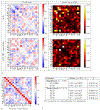Alcohol Use Disorder and Its Comorbidity With HIV Infection Disrupts Anterior Cingulate Cortex Functional Connectivity
- PMID: 33558196
- PMCID: PMC8160024
- DOI: 10.1016/j.bpsc.2020.11.012
Alcohol Use Disorder and Its Comorbidity With HIV Infection Disrupts Anterior Cingulate Cortex Functional Connectivity
Abstract
Background: Individuals with alcohol use disorder (AUD) have a heightened risk of contracting HIV infection. The effects of these two diseases and their comorbidity on brain structure have been well described, but their effects on brain function have never been investigated at the scale of whole-brain connectomes.
Methods: In contrast with prior studies that restricted analyses to specific brain networks or examined relatively small groups of participants, our analyses are based on whole-brain functional connectomes of 292 participants.
Results: Relative to participants without AUD, the functional connectivity between the anterior cingulate cortex and orbitofrontal cortex was lower for participants with AUD. Compared with participants without AUD+HIV comorbidity, the functional connectivity between the anterior cingulate cortex and hippocampus was lower for the AUD+HIV participants. Compromised connectivity between these pairs was significantly correlated with greater total lifetime alcohol consumption; the effects of total lifetime alcohol consumption on executive functioning were significantly mediated by the functional connectivity between the pairs.
Conclusions: Taken together, our results suggest that the functional connectivity of the anterior cingulate cortex is disrupted in individuals with AUD alone and AUD with HIV infection comorbidity. Moreover, the affected connections are associated with deficits in executive functioning, including heightened impulsiveness.
Keywords: Alcohol use disorder; Alcoholism; Anterior cingulate cortex; HIV infection; Hippocampus; Orbitofrontal cortex; Resting state; fMRI.
Copyright © 2020 Society of Biological Psychiatry. Published by Elsevier Inc. All rights reserved.
Conflict of interest statement
Disclosures
All authors report no biomedical financial interests or potential conflicts of interest.
Figures




Similar articles
-
Developmental Differences in a Hippocampal-Cingulate Pathway Involved in Learned Safety Following Interpersonal Trauma Exposure.J Am Acad Child Adolesc Psychiatry. 2025 Jul;64(7):835-850. doi: 10.1016/j.jaac.2024.07.928. Epub 2024 Oct 3. J Am Acad Child Adolesc Psychiatry. 2025. PMID: 39368629 Free PMC article.
-
Aging, HIV infection, and alcohol exert synergist effects on regional thalamic volumes resulting in functional impairment.Neuroimage Clin. 2024;44:103684. doi: 10.1016/j.nicl.2024.103684. Epub 2024 Oct 12. Neuroimage Clin. 2024. PMID: 39423567 Free PMC article.
-
Triple network resting-state functional connectivity patterns of alcohol heavy drinking.Alcohol Alcohol. 2024 Jul 21;59(5):agae056. doi: 10.1093/alcalc/agae056. Alcohol Alcohol. 2024. PMID: 39129375 Free PMC article.
-
Baclofen for alcohol use disorder.Cochrane Database Syst Rev. 2023 Jan 13;1(1):CD012557. doi: 10.1002/14651858.CD012557.pub3. Cochrane Database Syst Rev. 2023. PMID: 36637087 Free PMC article.
-
Psychological therapies for post-traumatic stress disorder and comorbid substance use disorder.Cochrane Database Syst Rev. 2016 Apr 4;4(4):CD010204. doi: 10.1002/14651858.CD010204.pub2. Cochrane Database Syst Rev. 2016. PMID: 27040448 Free PMC article.
Cited by
-
A voxel-level resting-state fMRI study on patients with alcohol use disorders based on a power spectrum slope analysis method.Front Neurosci. 2024 Feb 15;18:1323741. doi: 10.3389/fnins.2024.1323741. eCollection 2024. Front Neurosci. 2024. PMID: 38426022 Free PMC article.
-
Relating Functional Connectivity and Alcohol Use Disorder: A Systematic Review and Derivation of Relevance Maps for Regions and Connections.Hum Brain Mapp. 2025 Feb 1;46(2):e70156. doi: 10.1002/hbm.70156. Hum Brain Mapp. 2025. PMID: 39917866 Free PMC article.
-
Proteomic Analysis of Chronic Binge Alcohol-Induced Hippocampal and Anterior Cingulate Cortex Neuroadaptations in Simian Immunodeficiency Virus (SIV)-Infected Female Rhesus Macaques.J Neuroimmune Pharmacol. 2025 Feb 10;20(1):16. doi: 10.1007/s11481-025-10179-5. J Neuroimmune Pharmacol. 2025. PMID: 39930298 Free PMC article.
-
Brain-Cognition Fingerprinting via Graph-GCCA with Contrastive Learning.Mach Learn Clin Neuroimaging (2024). 2025;15266:24-34. doi: 10.1007/978-3-031-78761-4_3. Epub 2024 Dec 6. Mach Learn Clin Neuroimaging (2024). 2025. PMID: 39872150 Free PMC article.
References
-
- Substance abuse and mental health services administration. In: Key substance use and mental health indicators in the United States: Results from the 2017 National Survey on Drug Use and Health (HHS Publication No. SMA 18-5068, NSDUH Series H-53). Rockville, MD: Center for Behavioral Health Statistics and Quality, Substance Abuse and Mental Health Services Administration; (2018), Retrieved from https://www.samhsa.gov/data/
-
- American Psychiatric Association: Diagnostic and Statistical Manual of Mental Disorders, Fourth Edition, Text Revision (DSM-IV-TR). American Psychiatric Press Inc., Washington, DC: (2000)
Publication types
MeSH terms
Grants and funding
LinkOut - more resources
Full Text Sources
Medical

